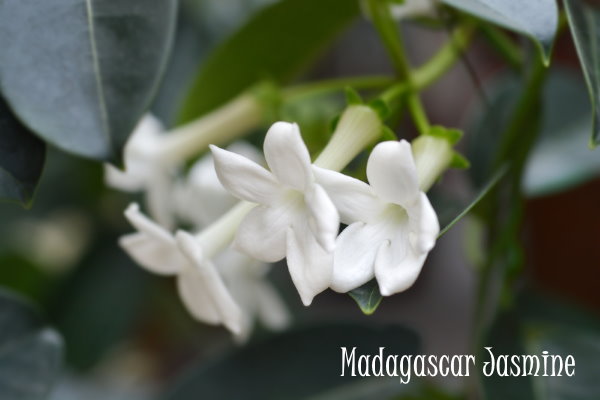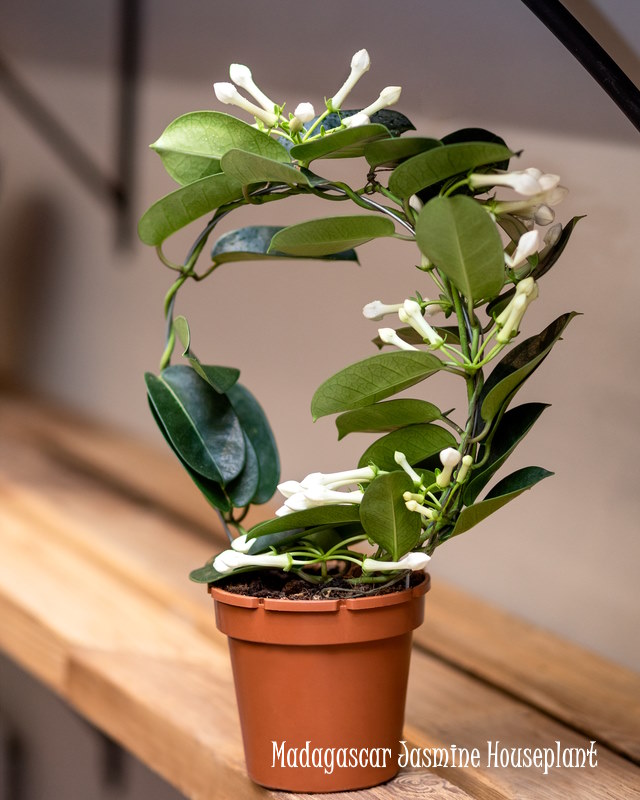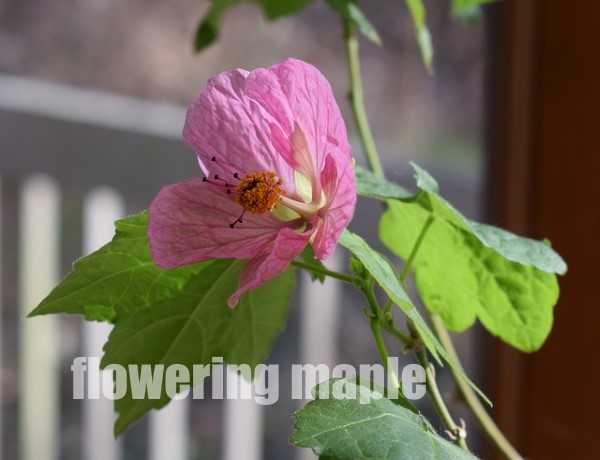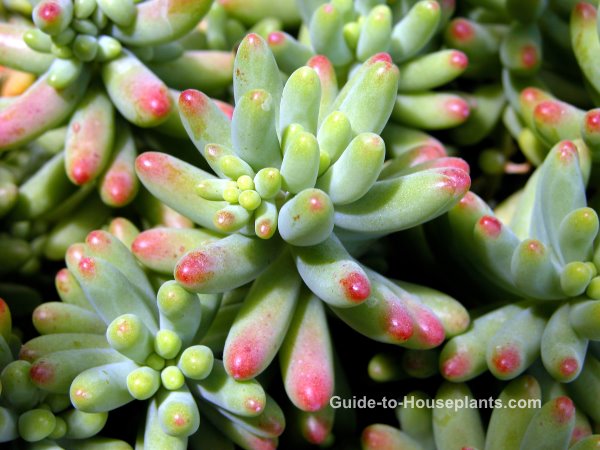Madagascar Jasmine
Add spectacular fragrance to a room with Madagascar jasmine. It's a beauty, too. Those long thick vines are densely covered with glossy, evergreen leaves and an abundance of white star-shaped flowers.
 Jasmine-like tubular flowers open up to 5 spreading lobes, anytime from spring to autumn.
Jasmine-like tubular flowers open up to 5 spreading lobes, anytime from spring to autumn.Get to Know Madagascar Jasmine Houseplant
Known botanically as Stephanotis floribunda, this tropical climbing vine is a highly sought after houseplant. However, it's not the easiest to please. This Madagascar native demands consistent conditions to grow, bloom and thrive.
If you can meet its needs, you'll be rewarded with one of the most captivating, fragrant, flowering houseplants you'll find anywhere.
How big does Madagascar jasmine get? Allowed to grow, this vine is capable of reaching 10 ft (3 m) or more, if not pruned back.
It is a strong climber, and is often sold twined around a wire hoop inserted in a pot. If you buy a young plant, you can add your own hoop or trellis for it to climb.
Is it poisonous? No -- you don't have to worry about this one. According to the ASPCA, Madagascar jasmine is non-toxic to cats, dogs and people.
About those Fragrant Flowers
Clusters of creamy white, tubular flower buds arise from the leaf axils. Give your plant plenty of light, and you can expect a profusion of 5-petaled, waxy flowers from spring through autumn. Each beautifully scented bloom lasts for several days.
How fragrant? One small plant is enough to fill a whole room with a delightfully sweet scent. Also called Hawaiian Wedding Plant, the pristine white blooms are popular for bridal bouquets.
No blooms? Lack of sunlight is the top reason for lack of flowers. Put your jasmine plant in a sunny window, sunroom or greenhouse to give it the light it needs. Young plants may not bloom much, so be patient -- the wait is worth it.
Stephanotis Floribunda Problems, Solutions and To-Dos
Prune it back. After the flowers fade, prune stems back harshly. Plants that aren't pruned back will eventually have bare lower stems as they shed old leaves. Flower buds develop on new growth, so you'll get more blooms this way.
Pruning tip: Prune back in late fall or early winter to control its size and to prevent bare stems. It's a good idea to keep the vine to around 2-3 ft (60-90 cm).
Repot in spring only when the roots have filled the pot. Madagascar jasmine blooms best when slightly pot-bound, so use a smallish container or you may see a lot of leaves and few flowers.
Support your vines. You can easily train it around a hoop or over a small trellis inserted in the pot. Tie it to the support with florist wire as it grows.
Flowers falling off? Dropped flower buds and flowers may be caused by sudden changes in light, temperature or moisture. See care tips below.
Something bugging your plant? Wet, peaty potting mixtures may draw fungus gnats. They're tiny and black -- hardly noticeable, but you may see them stirring when you water your plant. Look under the leaves and you may find scale insects. You can scrape them off with your fingernail, but it's also a good idea to treat any infested plant with insecticide.
Brown, dry leaves are caused by too much sunlight or dry soil.
Yellow leaves? You overwatered. Use a pot with drainage holes for water to escape. Allow the top couple inches of the potting medium to dry out before watering again. You can cut off any yellow leaves, if you want. This vigorous vine will replace them.
 Train this fragrant flowering vine around a hoop to show it off. Photo credit © Farhadib
Train this fragrant flowering vine around a hoop to show it off. Photo credit © FarhadibMadagascar Jasmine Care Tips
Light: Jasmine needs bright, indirect light to bloom. Shade from hot, direct summer sun. Once it grows flower buds, don't move Madagascar jasmine around; changes in light -- even by turning the plant around -- may cause the buds and flowers to fall off.
Water: Spring through fall, water thoroughly until water comes out the bottom of the pot. Allow the soil to dry out a bit before watering again. Keep barely moist in winter, after flowering is over. If the plant wilts, it's too dry. Overwatering will cause leaves to turn yellow and fall off.
Humidity: Ideally 60%. If the relative humidity drops below 50%, use a room humidifier or humidity tray.
Temperature: Give this tropical jasmine warm temperatures (65-75°F/16-24°C) year-round. It will tolerate temps down to 50°F/10°C. Stephanotis floribunda doesn't like fluctuating temps, so keep them away from drafty windows and doors, or heat/AC vents.
Soil: Peat moss-based potting mix with a handful of perlite or horticultural sand added to improve drainage.
Fertilizer: Feed every 2 weeks in spring and summer with a high-phosphorus liquid fertilizer.
Propagation: Stem cuttings do not root easily, but here's how: Take 4 in (10 cm) stem tip cuttings in early summer, dip cut ends in hormone rooting powder and stand them in moist perlite. Maintain warmth (75°F/24°C) for the cuttings; it's a good idea to use a seedling heat mat. Sow seeds in spring.


